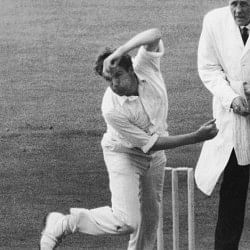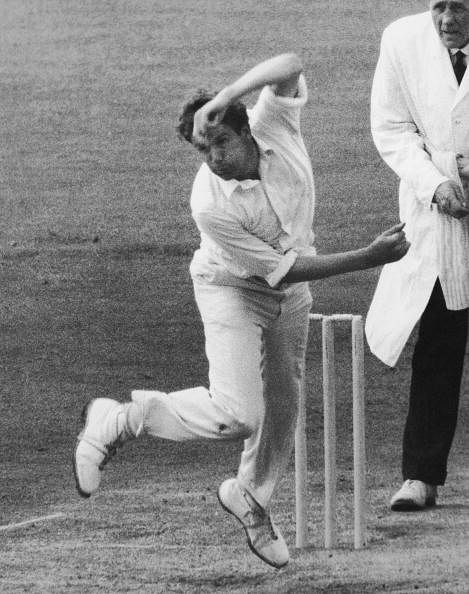
The man who bowled at 90 m/hr in 1960s - An Interview with Harold Rhodes, Part - 4

Derbyshire bowler Harold Rhodes
How fast were you at your quickest? Who was faster than you?
Frank Tyson was frighteningly quick for a few years, as was Fred Trueman, but I wasn’t far off. I was never timed when I was at my fastest, but a rudimentary test conducted by a couple of school masters suggested I was bowling around 94 mph in the early 1960s.
The thing was, you couldn’t bowl fast all the time. We played so much – I bowled around seven to eight hundred overs a season – that you kept yourself back for days when the wicket offered you more help, or for the last day of a game when you were pressing for a win. That’s when the accuracy that I mentioned earlier came in – you relied on line and length and occasional quicker balls to keep people guessing.
Walter Goodyear was our groundsman at this time and the accuracy of the likes of Cliff and Les was extraordinary. At the end of the season, he said that he only had to take around a yard of turf out and replace it, as the rest was pretty much pristine. They were remorseless in giving the batsmen nothing to hit and bowling perfect lengths.
It was difficult too, because there was none of this quick drying cement that they use to fill footholds today. Les used to create massive ‘bomb craters’, as we called them, when he bowled, so you had to make sure that you didn’t land your front foot in, or on the edge of one of those, or you could easily turn an ankle.
How fast was a bowler of a later vintage, Alan Ward?
When he came on the scene in the mid-1960′s I was in my 30′s and he made me look slow, at that stage, in comparison! He was a very quick bowler indeed and there were a few county batsmen who didn’t fancy facing him at all.
He never fulfilled that potential though. I don’t think he really had the heart for it when he came up against better batsmen who could handle him and when he had the bad days that all bowlers endure. Injuries came along and Alan disappeared far more quickly than he should have done. It was a shame, really.
I was interested to read that you rarely bowled bouncers. Was that to maintain control and avoid giving easy runs away?
Yes, it was. It goes back, I suppose, to seeing Frank Tyson ‘waste’ the new ball as I mentioned earlier. It was a bonus if it took a wicket, but those who hooked usually saw it as an easy four, while those who didn’t just ducked under it and it usually meant that you were wasting your time and energy. I always used to think that bowling a bouncer showed that the batsmen were rattling me, so I didn’t bother.
Our batsmen used to get annoyed sometimes, as they wanted me to dish out some of what they had to put up with. I preferred to try and win the match and to do so had to keep runs to the minimum and take wickets as inexpensively as possible.
How did the salary of a professional cricketer relate to an ordinary working man at that time?
When I was capped in 1958 my salary was £600 a year (around 12K today). That was the same as Cliff and Les, as well as all the other capped players, You got no more for experience or good performances. You certainly didn’t play county cricket for the lavish lifestyle, but Arnold Hamer told me that it would create memories, and it was all about the people you met and had a beer with at the end of the day.
That’s a side of the game that has slowly disappeared and it’s a shame. You learned a lot from talking to other players and most of us got on pretty well.
That’s a side of the game that has slowly disappeared and it’s a shame. You learned a lot from talking to other players and most of us got on pretty well.